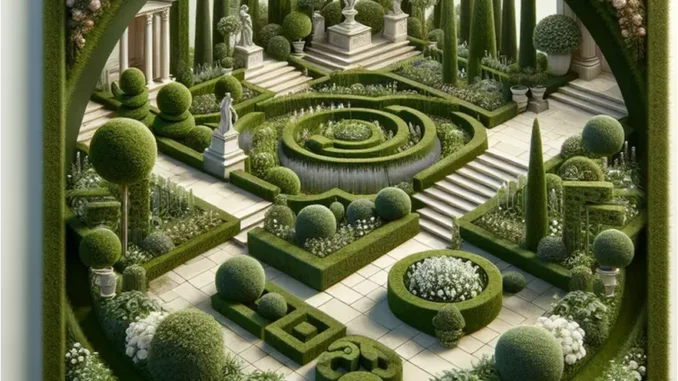
In conversation with the talented gardener, Margaret Collins, it became clear that the allure of Formal Gardens lies not only in their timeless elegance but also in their adaptability to any size of garden. As Margaret eloquently put it, “A Formal Garden is like a living sculpture – it’s all about lines, shapes, and the art of symmetry.” Her insights shed light on how anyone, regardless of their garden’s size, can create a sublime outdoor space through thoughtful design and meticulous care.
Margaret has been a passionate gardener for over two decades, and her expertise in the realm of Formal Gardens is both extensive and inspiring. As we strolled through her own meticulously curated garden, she shared her journey and some invaluable tips for those looking to embark on their own Formal Garden projects.
The Essence of Formal Gardens
“A Formal Garden,” Margaret began, “is characterised by its structured appearance. It’s a style that thrives on geometric layouts and well-defined sections. Think of it as an outdoor canvas where you can paint with hedges, stone, and greenery.”
Indeed, the sight of perfectly pruned hedges and shrubs, stone pathways, and elegant focal points such as fountains or statues is a testament to this style’s enduring appeal. Margaret emphasises that symmetry and balance are paramount. “When you arrange your garden elements in a symmetrical fashion, it brings a sense of harmony and calm,” she explained.
Adapting to Any Space
One of the most compelling aspects of Formal Gardens is their versatility. Margaret illustrated this point by showing how her own garden, though not expansive, was transformed into a serene oasis. “You don’t need a sprawling estate to achieve this look,” she assured me. “Even a small urban garden can be converted into a Formal Garden with the right approach.”
The key, Margaret revealed, lies in the use of lines and shapes. “By incorporating straight lines and well-defined shapes, you can create the illusion of space and order,” she said. For smaller gardens, elements like potted plants and small hedges can replicate the grandeur of larger formal gardens. “Simple plants such as liriope and buxus are fantastic for this purpose. They’re hardy and can be easily shaped to fit your design.”
The Art of Topiary
For the truly skilled gardener, topiary offers an exciting opportunity to elevate a Formal Garden. Margaret’s eyes sparkled with enthusiasm as she spoke about this art form. “Topiary is a perfect fit for Formal Gardens,” she explained. “It’s the practice of training plants to grow into specific shapes, and it adds a touch of whimsy and sophistication.”
She guided me to a section of her garden where a series of topiary creations stood proudly. From spirals to animal shapes, each topiary was a work of art. “The trick is patience and precision,” Margaret advised. “It takes time to train the plants, but the results are well worth the effort. Topiary can serve as striking focal points in your garden, drawing the eye and adding depth.”
Choosing the Right Elements
Margaret stressed the importance of carefully selecting elements to include in a Formal Garden. “Less is often more,” she noted. “Don’t overcrowd your garden with too many design elements. Instead, focus on creating balance by mirroring shapes, colours, and plants.”
White is the predominant colour in Margaret’s garden, with clusters of white blooms set against green foliage. “White brightens up any shady area and adds a touch of elegance,” she said. For those who desire a pop of colour, she recommended lavender. “The royal purple of lavender complements the green and white beautifully, without disrupting the formal aesthetic.”
Natural paving, stone pots, statues, and figurines are also integral to the Formal Garden. “These elements help to create a formal atmosphere,” Margaret explained. “Stone pathways and courtyards lend a sense of permanence and structure, while statues and urns add a classical touch.”
Creating Your Own Formal Garden
As we concluded our tour, Margaret offered some final advice for aspiring Formal Garden enthusiasts. “Start with a plan,” she advised. “Sketch out your garden layout, considering the lines, shapes, and focal points you want to incorporate. Use repetition to create a cohesive look, and don’t rush the process. Gardening is as much about the journey as it is about the destination.”
Margaret’s passion for Formal Gardens was evident in every word she spoke and every corner of her garden. Her dedication to this timeless style is a reminder that, with patience and creativity, anyone can transform their outdoor space into a haven of elegance and tranquillity.
Conclusion
The allure of Formal Gardens lies in their structured elegance and adaptability. Through careful planning, the use of lines and shapes, and the art of topiary, any garden, regardless of size, can be transformed into a masterpiece of symmetry and balance. Margaret Collins’ insights and expertise are a testament to the beauty and versatility of this timeless garden style. Whether you have a small urban garden or a larger estate, the principles of Formal Gardens can help you create a serene and stylish outdoor space that you’ll cherish for years to come.
John Williams


Be the first to comment